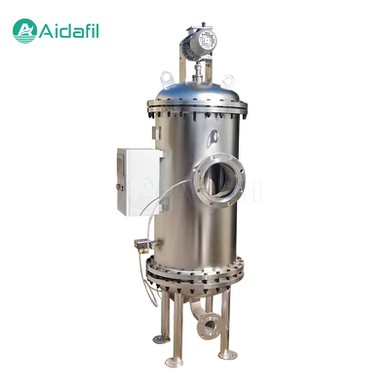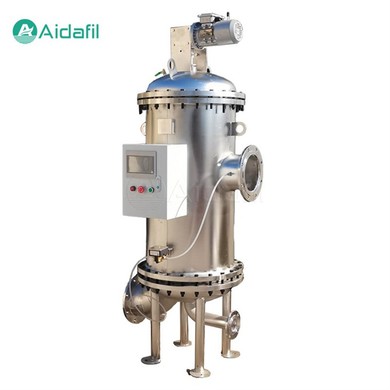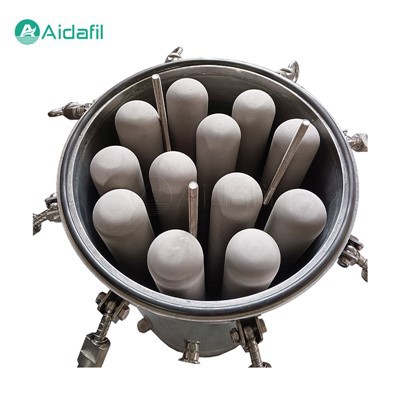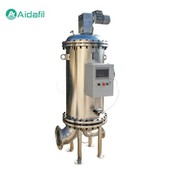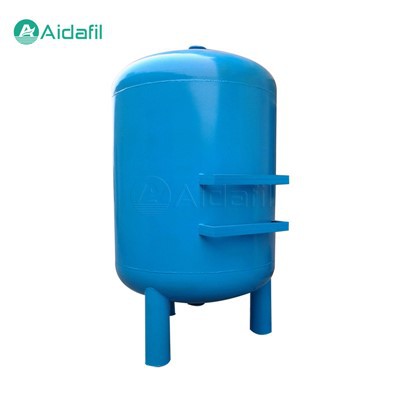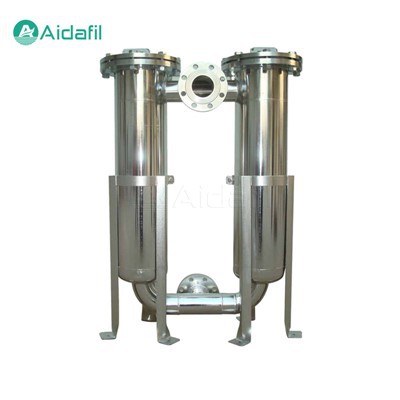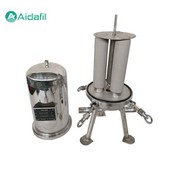
Large Flow Automatic Backwash Filter
Product Details
The large flow automatic backwash filter operates by directing the fluid to be filtered into the filter housing, where it passes through a filter element. As the fluid flows through the filter element from the inside to the outside, solid particles are trapped on the inside of the filter element while the clean fluid exits the filter housing. When the filter becomes sufficiently contaminated, the pressure difference between the dirty and clean sides of the filter increases. Once this pressure difference reaches a predetermined level, the backwash process is initiated automatically to clean the filter element.
Technical Parameters
|
Filtration precision |
20-400 microns |
|
System working pressure |
0.2-1.0Mpa |
|
Backwash requires water pressure |
≥0.18Mpa |
|
Medium temperature |
<60 degrees |
|
Power supply voltage |
AC220V 1A |
|
Control output voltage |
DC24V 1A per channel |
|
Control mode |
Differential pressure, timing, manual |
|
Pipe material |
Carbon steel, stainless steel, HDPE, etc. |
Key Components
1. Filter Housing. The filter housing contains the filter element and provides structural support for the entire system. It is designed to withstand high pressures and temperatures.
2. Filter Element. The filter element is the heart of the automatic backwash filter. It captures solid particles from the fluid stream as it passes through. Filter elements are available in various materials and configurations to suit different applications.
3. Backwash Mechanism. The backwash mechanism is responsible for cleaning the filter element when it becomes fouled. It typically consists of a backwash valve, a control system, and a flushing system.
4. Pressure Differential Sensor. This sensor monitors the pressure difference between the dirty and clean sides of the filter element. When the pressure difference exceeds a set threshold, it triggers the backwash process.
5. Flush Outlet. The flush outlet is where the filtered contaminants are discharged during the backwash cycle.
Operating Principle
1. Filtration Stage. The fluid to be filtered enters the filter housing through the inlet and passes through the filter element. Solid particles are trapped on the inside of the filter element, while the clean fluid exits through the outlet.
2. Pressure Monitoring. As the filter collects more contaminants, the pressure difference between the dirty side (inlet) and the clean side (outlet) of the filter element increases. This pressure difference is continuously monitored by the pressure differential sensor.
3. Backwash Initiation. When the pressure difference reaches a preset value, the pressure differential sensor signals the control system to initiate the backwash process.
4. Backwash Cycle. The backwash valve opens, allowing a portion of the filtered fluid to flow backward through the filter element. This reverse flow dislodges and carries away the trapped contaminants, which are then discharged through the flush outlet.
5. Rinse and Recovery. After the backwash cycle, the backwash valve closes, and the filter returns to its normal filtration mode. Some systems may include a rinse cycle to ensure that all contaminants are thoroughly removed before resuming normal operation.
Advantages
1. Continuous Filtration. Automatic backwash filters provide continuous filtration without the need for manual intervention, ensuring consistent product quality and process efficiency.
2. Reduced Downtime. By automatically cleaning the filter element as needed, these filters minimize downtime associated with maintenance and filter replacement.
3. Improved Efficiency. The backwash process prevents the buildup of contaminants on the filter element, allowing for efficient operation over extended periods.
4. Cost Savings. While automatic backwash filters may have higher upfront costs compared to manual filters, they offer long-term cost savings due to reduced labor and downtime.
Applications
1. Water Treatment: Automatic backwash filters are widely used in municipal water treatment plants, industrial wastewater treatment, and desalination facilities to remove suspended solids and improve water quality.
2. Oil and Gas: In the oil and gas industry, these filters are employed for the filtration of produced water, hydraulic fracturing fluids, and refinery process streams to protect equipment and ensure product purity.
3. Chemical Processing: Automatic backwash filters play a critical role in chemical processing applications such as resin filtration, catalyst recovery, and process water filtration.
4. Food and Beverage: From breweries to soft drink manufacturing, automatic backwash filters are utilized to remove impurities from process water, ingredients, and final products, ensuring compliance with quality standards.
FAQ
1. Q: What is the function of a filter?
A: The main function of a filter is to remove solid particles, impurities, and harmful substances from liquids or gases, in order to achieve purification, clarification, and protection of equipment.
2. Q: How to choose a suitable filter?
A: When choosing a filter, factors such as the properties of the material being filtered (e.g., viscosity, temperature, corrosion), required filtration accuracy, processing capacity, operating pressure and medium, as well as the type, material, size, and installation method of the filter should be considered.
3. Q: What is the working principle of a filter?
A: The working principle of a filter mainly relies on physical screening, deep interception, absorption, or chemical reactions to remove impurities or harmful components from the material being filtered.
4. Q: How to maintain and care for a filter?
A: Maintenance of filters includes regular cleaning or replacement of filter elements, inspection of seals and fasteners, maintaining stable operating pressure, and avoiding overloading. Specific methods should be referenced from the filter's instruction manual and maintenance guides.
5. Q: What is the service life of a filter?
A: The service life of a filter depends on its working environment, processing volume, and filtration accuracy. Generally, when the filter's pressure drop reaches a certain value or the filtration effect decreases significantly, it needs to be replaced or cleaned.
6. Q: What should be paid attention to during filter installation?
A: During filter installation, attention should be paid to the directionality, ensuring that the fluid enters and exits from the correct ports. Also, the piping system should be cleaned before installation, and the filter should be securely fastened and sealed as required by the instructions.
7. Q: What is the replacement cycle for filters?
A: The replacement cycle for filters depends on their working conditions and filtration requirements, and is usually indicated by pressure difference indicators or timers. When the filter's pressure drop reaches the set value or the filtration effect decreases, it should be replaced in a timely manner.
Why Choose Us
· Professional manufacturer with many years' experience
· Good quality with competitive price
· OEM & ODM are welcome
· Various payment items are acceptable
· Good service by experienced manager
AIDA Philosophy
1. Management Concept:
· Satisfy the customers' demand --- Touch customers, trust with our products and services
· Make employees happy --- Pursue higher material and spiritual happiness
2. Company Mission:
· Focus on customer needs, provide best filtering solution
· To be the lifelong partner with customers
3. Corporate Vision:
· Become a global purification leadership brand
4. Values:
· Customer: Pursue the ultimate experience, enjoy excellent quality
· Team: Trust, responsibility, growth, win-win
· Work: Simple, sincere, efficient, dedicated
Hot Tags: large flow automatic backwash filter, China, factory, price, buy, efficient self cleaning screen filter, coalescing filters for oil removal, 500um stainless steel duplex strainer, multicolor screw compressor air filter, spin on compressor air oil separator, Sintered Wire Mesh

